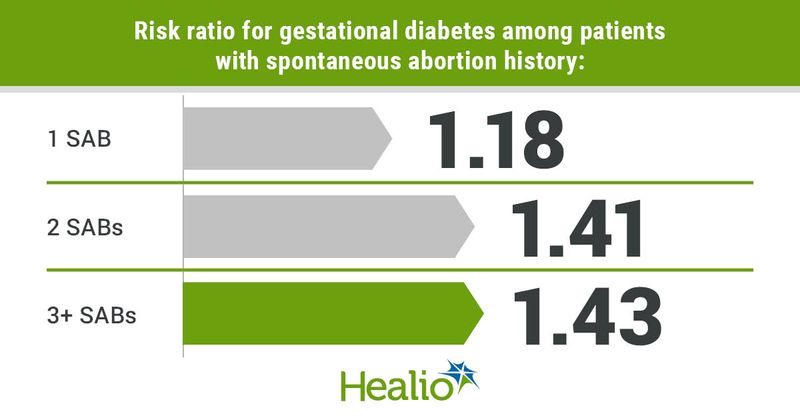History of spontaneous abortion may increase risk for gestational diabetes
Having a history of spontaneous abortion increased the risk for gestational diabetes in a retrospective cohort of pregnant Chinese women, as did a history of both spontaneous and induced abortion.
“It is estimated that up to 30% of all pregnancies terminate in spontaneous abortion (SAB), and more than 43 million elective induced abortions occur annually worldwide,” Yan Zhao, PhD, of Tongji University School of Medicine in Shanghai, China, and colleagues wrote in JAMA Network Open. “Studies have shown that SAB, especially recurrent SAB, is associated with later maternal risk of cardiovascular disease and venous thromboembolism, and women with a history of induced abortion are at higher risk of developing metabolic diseases, including type 2 diabetes, later in life.”

“The pathophysiological mechanisms for the elevated cardiovascular and metabolic disease risk might be associated with oxidative stress and inflammation, which also contribute to the development of [gestational diabetes (GD)],” the researchers wrote. “However, whether prior abortion would be associated with increased maternal risk of GD in subsequent pregnancies remains unclear.”
Identifying abortion, gestational diabetes
Zhao and colleagues analyzed data from 102,259 women (mean age, 29.8 years) who received routine antenatal care at their tertiary care hospital between January 2014 and December 2019. They included women who underwent a standard oral glucose tolerance test (OGTT) between 24 and 28 weeks’ gestation and excluded those with multiples or with a history of GD or chronic diseases.
The researchers compared the incidence of GD in 65,728 women with no abortion history, 14,579 women who experienced SAB only, 17,935 women who experienced induced abortion only and 4,017 women who experienced both SAB and induced abortion.
Women with a history of abortion were more likely to be multiparous, have obesity and be older than 35 years compared with women with no abortion history.
Prevalence of gestational diabetes
OGTT scores revealed that 7,018 women (10.7%) in the no abortion group, 2,282 women (15.7%) in the SAB only group, 2,213 women (12.3%) in the induced abortion only group and 640 women (15.9%) in the SAB and induced abortion group had GD.
Compared with women without a history of abortion, GD risk was higher in women with a history of SAB only (RR = 1.25; 95% CI, 1.18-1.31) and those with a history of both SAB and induced abortion (RR = 1.15; 95% CI, 1.05-1.27). There were no associations in the induced abortion only group.
Further analyzing SAB, Zhao and colleagues found a positive correlation between the number of SABs and risk for GD. Compared with women with no history of abortion, one SAB increased the risk for GD by 18% (RR = 1.18; 95% CI, 1.11-1.26), two SABs increased the risk by 41% (RR = 1.41; 95% CI, 1.27-1.57) and more than two SABs increased the risk by 43% (RR = 1.43; 95% CI, 1.22-1.67).
‘Early prevention and intervention’
Zhao and colleagues said the results of their analysis “suggest that pregnant women with a history of SAB, especially those with a history of recurrent SAB, should attend more antenatal visits to monitor their blood glucose and implement early prevention and intervention (eg, eating more healthfully and doing regular physical activity).”
“Considering the short- and long-term adverse effects of GD on both mothers and their offspring, our findings may also have potential public health implications,” they added.
Since the information extracted from medical records was self-reported, the researchers cautioned that the incidence of abortion may be underreported in their cohort, thus underestimating the correlation between SAB and GD. They also noted that the time SAB occurred could not be examined in the study due to lack of data.
Moving forward, Zhao and colleagues suggested studies aim “to clarify this association and explore the potential biological mechanisms underlying the association.”

